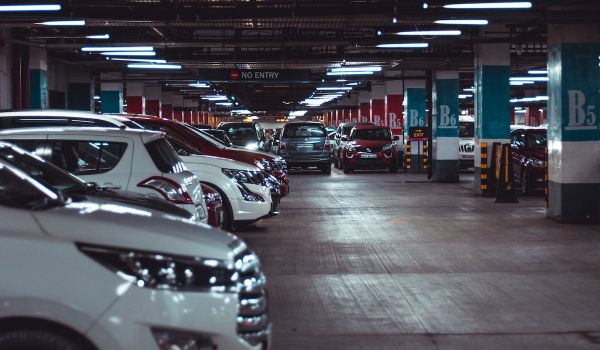This article was originally publshed on Strong Towns.
A new tool from the Parking Reform Network (PRN) illustrates that downtown Cleveland is 26% parking lot. The centers of nearby Columbus and Detroit are 27% and 30% parking lot, respectively. Although they each hover around one-third, these Midwestern cities lag behind San Bernardino, California, and Arlington, Texas, which currently lead the country when it comes to ceding city land to surface lots: 45% and 42% respectively.
The Parking Lot Map has analyzed the land-uses of over 80 major cities across the country, cementing the case that, on average, too much surface area is handed over to storing empty vehicles.
What’s especially handy about the Parking Lot Map tool is that it visually reinforces how much land is available in a given “central city” (a term PRN invented for this map “to encompass the densest, most centrally located, and most valuable real estate in a metropolitan area”) for more productive development, like housing, retail, plazas, and more. Seeing your city painted red can be demoralizing, but for PRN, these lots are places of opportunity.
What’s Lost to Parking?
“We have parking instead of people space,” Karen Kress, senior director of transportation and planning at the Tampa Downtown Partnership, told Creative Loafing Tampa Bay. “We’re wasting a lot of space, especially with the housing crisis.”
In fact, twice as much land is used for parking lots as for greenspace in Tampa, a ratio the city’s planners are eager to flip. Furthermore, the parking that does exist is underutilized. A survey of the city’s central and business districts revealed 6,000 of the 24,000 available spaces were unused during peak hours.
Elsewhere, like in Salt Lake City, 29% of which is parking lots according to PRN, prioritizing parking has inhibited the expansion of the city’s public transportation network, according to some advocates. “We are embedding, in a way, a continuation of the auto-oriented systems that we have been trying for a long time to work through,” says Brenda Scheer, a member of the city’s Planning Commission. She was the lone opposition to a 90-foot 926-car parking garage ultimately approved for a site formerly envisioned for transit expansion.
Willmar — a city of approximately 20,000 in the middle of Minnesota — recently eliminated its parking mandates, in part because people wanted less parking. Formerly, the minimum number of parking spots required was based on the square footage of a property, regardless of the property’s use and the owner or developer’s preferences. The formula was so unpopular that waiving the requirement for parking was Willmar’s most requested petition.
“Generally speaking, if you have that many variance requests around a single ordinance, you should change the ordinance,” Justice Walker, the city’s planning and development director, says. The hope now is that homeowners, retailers, and developers can not only more flexibly tailor their space to their needs, but that underutilized parking lots can eventually become structures the people of Willmar can appreciate. Additionally, city staff, no longer burdened by variance requests, can focus on the city’s more urgent needs.
But Where Will I Park?
On average, PRN found that 22% of all land in city centers of metropolitan areas with over a million people was dedicated solely to parking. Like in Tampa, many of these lots fail to fill up, even during peak hours. Strong Towns has long lampooned the expanses of asphalt on the busiest shopping day of the year with its #BlackFridayParking campaign. Countless images of half-empty lots offer a cheeky retort to the question: “But where will I park?”
Unsurprisingly for parking reform advocates, the answer to that very question lies in less parking. “Our research indicates that the percentage of land taken up by parking decreases as the percentage of individuals who opt for public transportation, walking, or biking as their primary commuting methods increases,” PRN wrote on the Parking Lot Map page, adding, “This revelation underscores a clear truth: to foster densely walkable cities, we must prioritize accessibility over excessive parking.”
For cities already confronting how parking has interfered with affordability, housing production, and even compliance with municipal comprehensive plans, looking toward surface lots as places of opportunity is a good next step. Unlike underground or podium parking (both of which are excluded from PRN’s analyses because they cannot be easily converted or redeveloped), surface lots can become places of play, retail, worship, dining, and anything other than car storage.
Asia (pronounced “ah-sha”) Mieleszko serves as a Staff Writer for Strong Towns. A dilettante urbanist since adolescence, she's excited to convert a lifetime of ad-hoc volunteerism into a career. Her unconventional background includes directing a Ukrainian folk choir, pioneering synaesthetic performances, photographing festivals, designing websites, teaching, and ghostwriting. She can be found wherever Wi-Fi is reliable, typically along Amtrak's Northeast Corridor.















